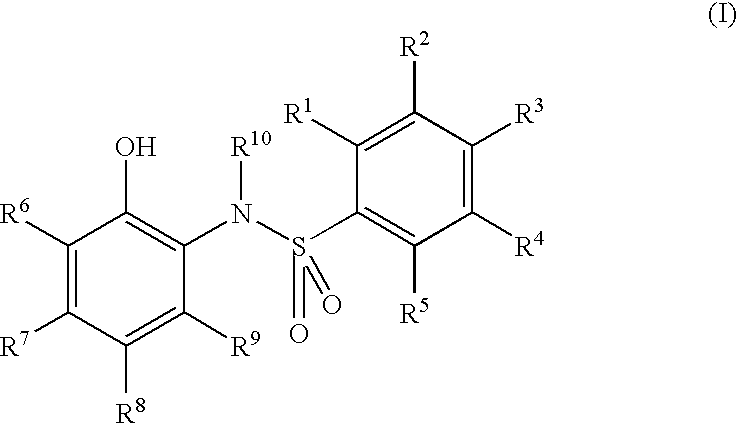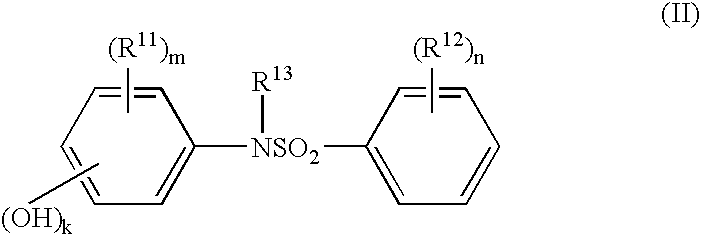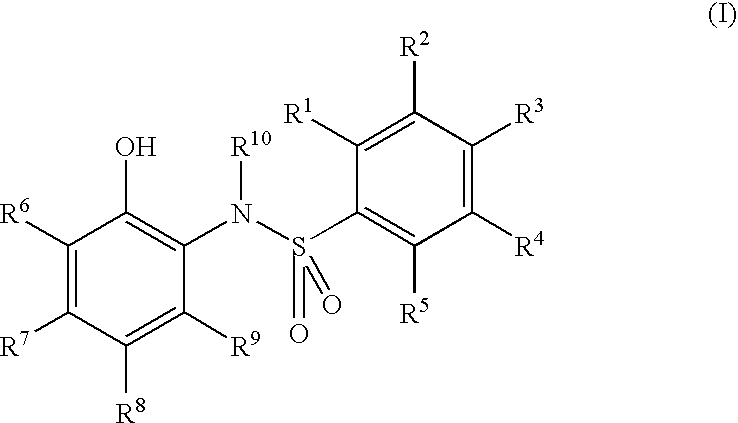Electron-receiving compound and thermal recording material
a technology of electronic receipt and recording material, which is applied in the field of electronic receipt compound and heat-sensitive recording material, can solve the problems of degrading recorded image, ground fogging, and loss of contrast between a ground and the recorded image, and achieve excellent ground/recorded image retainability, excellent thermal response, and excellent thermal response
- Summary
- Abstract
- Description
- Claims
- Application Information
AI Technical Summary
Benefits of technology
Problems solved by technology
Method used
Image
Examples
example 1
Synthesis of N-(2-hydroxyphenyl)-p-toluenesulfonamide
[0280]A flask with a stirrer was charged with 10.9 g of 2-aminophenol, 10.1 g of triethylamine and 100 ml of acetone, and a solution of 19.1 g of p-toluenesulfonyl chloride in 50 ml of acetone was dropwise added with cooling with ice over 30 minutes. After completion of the addition, the reaction mixture was stirred at room temperature for 2 hours and then poured into 500 ml of ice water. A precipitated crystal was recovered by filtration and washed with water. The obtained crystal was recrystallized from ethyl acetate / n-hexane mixed solvents, to give 13.0 g of an end product. Melting point 140.0° C.
[0281]A result of measurement of the product for 1H-NMR is shown below, and FIG. 1 shows its 1H-NMR chart.
[0282]1H-NMR in CDCl3 delta 2.39(3H,s), 6.73(1H,t), 6.82(1H,d), 6.90(1H,d), 7.06(1H,t), 7.22(2H,d), 7.61(2H,d).
example 2
Synthesis of N-(2-hydroxyphenyl)-benzenesulfonamide
[0283]A flask with a stirrer was charged with 10.9 g of 2-aminophenol, 10.1 g of triethylamine and 100 ml of acetone, and a solution of 17.7 g of benzenesulfonyl chloride in 50 ml of acetone was dropwise added with cooling with ice over 30 minutes. After completion of the addition, the reaction mixture was stirred at room temperature for 2 hours and then poured into 500 ml of ice water. A precipitated crystal was recovered by filtration and washed with water. The obtained crystal was recrystallized from ethyl acetate / n-hexane mixed solvents, to give 11.0 g of an end product. Melting point 140.0° C.
[0284]A result of measurement of the product for 1H-NMR is shown below, and FIG. 2 shows its 1H-NMR chart.
[0285]1H-NMR in CDCl3 delta 6.59(1H,t), 6.71(1H,d), 6.78(1H,d), 7.02(1H,t), 7.54(2H,t), 7.69(1H,t), 7.91(2H,d).
example 3
Synthesis of N-(2-hydroxyphenyl)-2-naphthalenesulfonamide
[0286]A flask with a stirrer was charged with 10.9 g of 2-aminophenol, 10.1 g of triethylamine and 100 ml of acetone, and a solution of 22.7 g of 2-naphthalenesulfonyl chloride in 50 ml of acetone was dropwise added with cooling with ice over 30 minutes. After completion of the addition, the reaction mixture was stirred at room temperature for 2 hours and then poured into 500 ml of ice water. A precipitated crystal was recovered by filtration and washed with water. The obtained crystal was recrystallized from ethyl acetate / n-hexane mixed solvents, to give 15.0 g of an end product. Melting point 136.0° C.
[0287]A result of measurement of the product for 1H-NMR is shown below, and FIG. 3 shows its 1H-NMR chart.
[0288]1H-NMR in CDCl3 delta 6.56(1H,t), 6.70(1H,d), 6.78(1H,d), 7.01(1H,t), 7.67(2H,m), 7.93(4H,m), 8.45(1H,s).
PUM
| Property | Measurement | Unit |
|---|---|---|
| diameter | aaaaa | aaaaa |
| diameter | aaaaa | aaaaa |
| diameter | aaaaa | aaaaa |
Abstract
Description
Claims
Application Information
 Login to View More
Login to View More - R&D
- Intellectual Property
- Life Sciences
- Materials
- Tech Scout
- Unparalleled Data Quality
- Higher Quality Content
- 60% Fewer Hallucinations
Browse by: Latest US Patents, China's latest patents, Technical Efficacy Thesaurus, Application Domain, Technology Topic, Popular Technical Reports.
© 2025 PatSnap. All rights reserved.Legal|Privacy policy|Modern Slavery Act Transparency Statement|Sitemap|About US| Contact US: help@patsnap.com



